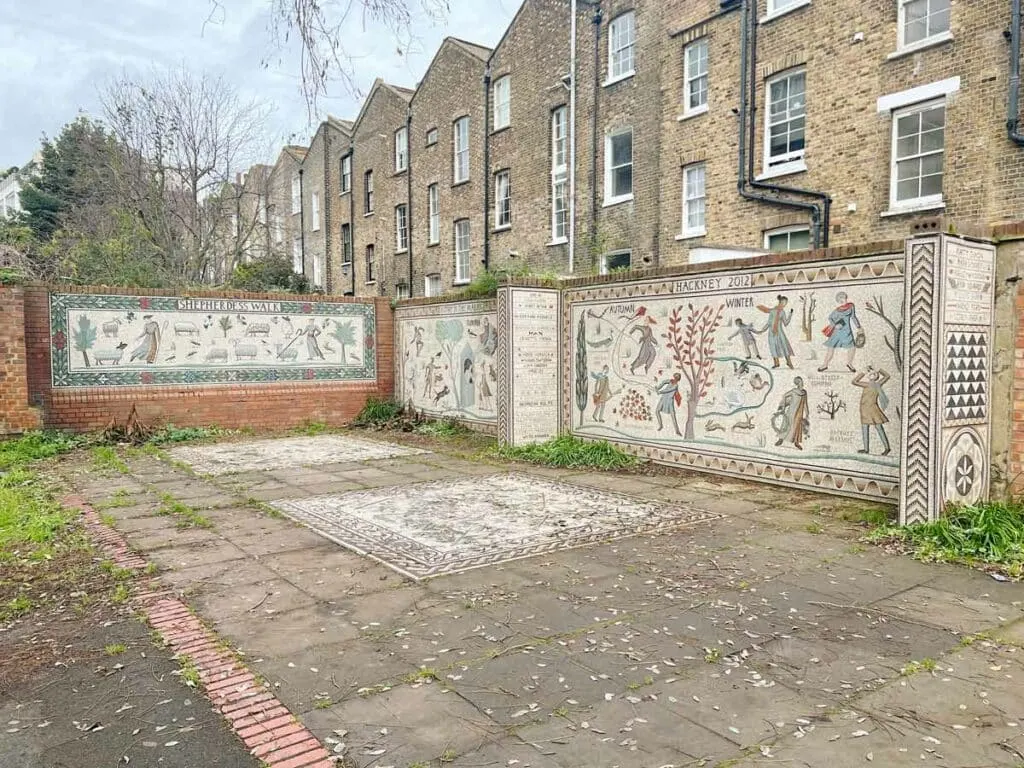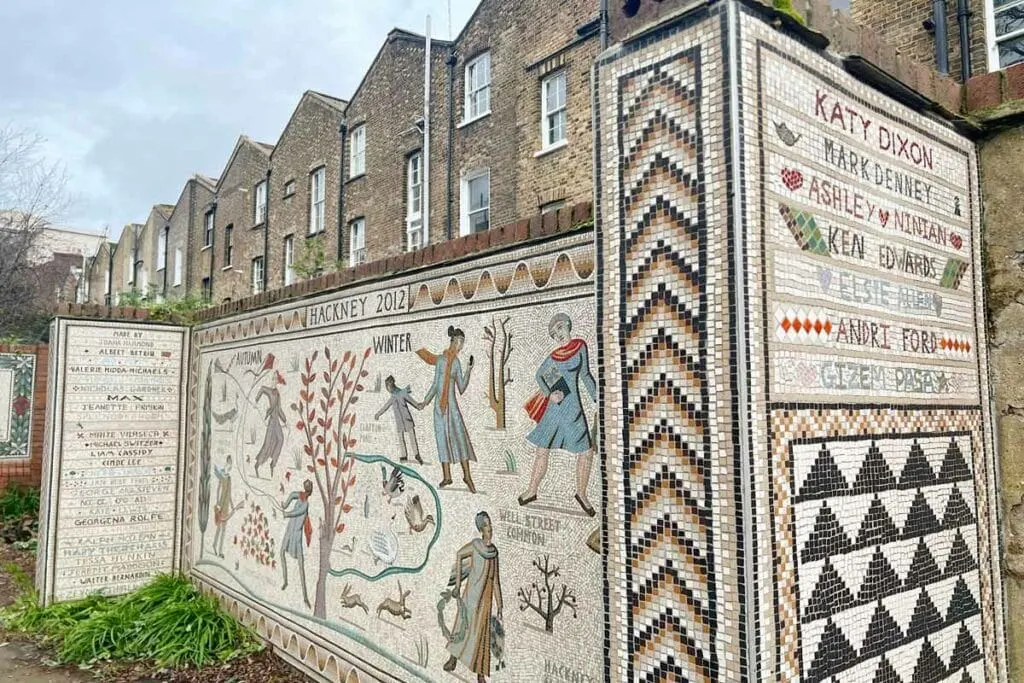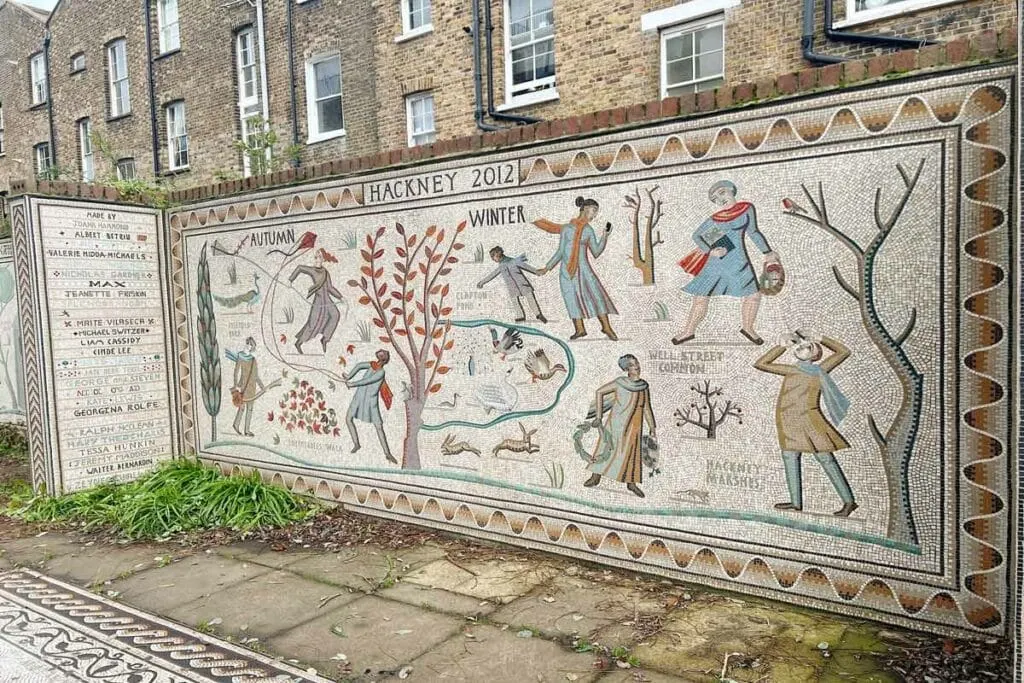Spotted the mosaics of Shepherdess Walk? Here’s what you need to know about this hidden spot in London.
Words by Olivier Guiberteau
On the surface, Shepherdess Walk, just a stone’s throw from Regents Canal in Hackney, is like any other London street. A jumble of smart terraced townhouses and lower-income housing blended with the kind of business we’ve come to expect in trendy East London.
But pause for a moment next to 107 Shepherdess Walk and you’ll notice a mysterious alleyway creeping below the houses with the intriguing words ‘To the Mosaics’ set into the white paintwork.
Make your way down the steps and through the cavernous alleyway and you’ll be rewarded with one of the city’s most unique, yet rarely visited, locations.
Why Visit the Shepherdess Mosaics?

Like most large cities, London can at times feel impersonal. With millions living in such a condensed area, it’s easy to lose that sense of community and individuality.
The dreaded tide of gentrification has meant that many areas of the city that once boasted a rich heritage and colourful tales have become somewhat bland in the pursuit of that distant goal that we usually call “progress.”
However, London is also a city of great surprises. A place where if you look hard enough you can still find pockets of genuine uniqueness and gems that tell the real story of this metropolis that we call our home.
The Shepherdess Mosaics is one such treasure. Tucked away from plain sight in the corner of Shepherdess Walk Park, it’s not uncommon to find yourself the only visitor to this secretive Hackney art installation that is now just over ten years old.
As you may gather from the name, what you’ll find after you pass through the dark passageway (you can also reach it via the park entrances, but why ruin a good experience) is a series of mosaics that paint the colourful story of the local area.
Created from a style commonly used in Roman Britain, but actually developed by the Ancient Greeks, the mosaics have become a treasured icon that still manages to fly well under the radar. This is not the National Gallery, but it is London street art at its very best.
The History of the Shepherdess Walk Mosaics
Historic Routes

While their style certainly harks back to the Roman era, their heart lies very much in the 21st Century. The first mosaic was unveiled shortly before the opening of the Olympic games in London in 2012, with further additions added the following year.
It’s been a long time since shepherds and shepherdesses were a fixture of the London landscape but the passageway through which you can reach the mosaics follows a historic path that once connected the open grazing lands of Islington with the City of London. And, specifically, the Smithfield Meat Market where sheep would be sold.
The surrounding area has changed dramatically since the days of livestock trundling through, with industry coming and going and the city of London exploding in all directions.
The passageway leading from Shepherdess Walk into the Shepherdess Walk Park was once known as Turner’s Place where the two largest bathhouses in London stood back in the 19th Century.
With the Olympics coming to London in 2012, the city saw countless projects that looked to brighten up the Big Smoke and commemorate the occasion. And one such project was the Shepherdess Walk Mosaics.
Tessa Hunkin
The work was the brainchild of Tessa Hunkin, a local artist specialising in mosaics whose projects can be seen across the city, including a piece inside Westminster Cathedral. Hunkin has been creating mosaics for 25 years and sees collaborative art projects such as these as excellent tools to help those suffering from mental health issues.
The first mosaic designed by Hunkin was titled ‘History in the Making’ with work beginning in the summer of 2011. What began as just two separate pieces eventually blossomed into what you see today, with three large panels and smaller pieces on some of the side walls.
In total, over 150 people worked on the project in one way or another, making it a much-loved community project. This included several volunteers who were part of a local drug and alcohol outreach program and the idea of creating something that could help those with mental health issues remained the cornerstone of the entire project.
The Story of Hackney
The first two panels unveiled in 2012 depicted the four seasons, but with a distinctive local flavour. The mosaics may carry a Romanesque feel to them but peer closely and you’ll see they are firmly rooted in the 21st Century.
The winter section portrays a mother and son beside Clapton Pond, the son reaching forward to feed bread to the ducks while his mother faces the other way on her mobile phone – a most modern scene – while autumn shows kites swirling through the sky and a man blowing away fallen leaves.
Summer is all about ice creams, dips in the local lido, and picnics on London Fields, while spring shows a skateboarder dropping in at Haggerston Park and a man playing catch with his dog on Hackney Downs.
Despite only receiving funding for six months, the project was such a success that the artists simply kept going and in 2013 a third large panel appeared that commemorated the site’s link with the shepherds and shepherdesses of yesteryear.
A Community Project

Despite its out-of-the-way location, the Shepherdess Walk Mosaics has become a hugely popular symbol of the local area. A project that not only showcases an art form that we rarely see anymore because of its time-consuming nature but also connects us with our distant past.
This city can, at times, be a victim of its own success. As London surges forward with new megastructures and large dazzling projects, smaller, more intimate touches are gradually left behind and eventually forgotten.
The next time you’re in Hackney, take the time to pass beneath 107 Shepherdess Walk and you’ll be rewarded with a beautiful piece of art painstakingly constructed that portrays both London’s forgotten past and its glorious present.
Shepherdess Walk: Practical Information
Address: The passageway is next to 107 Shepherdess Walk, but the Mosaics can also be accessed directly from the park with entrances from Sturt Street and Wenlock Road.
Opening Times: Open 24 hours a day

